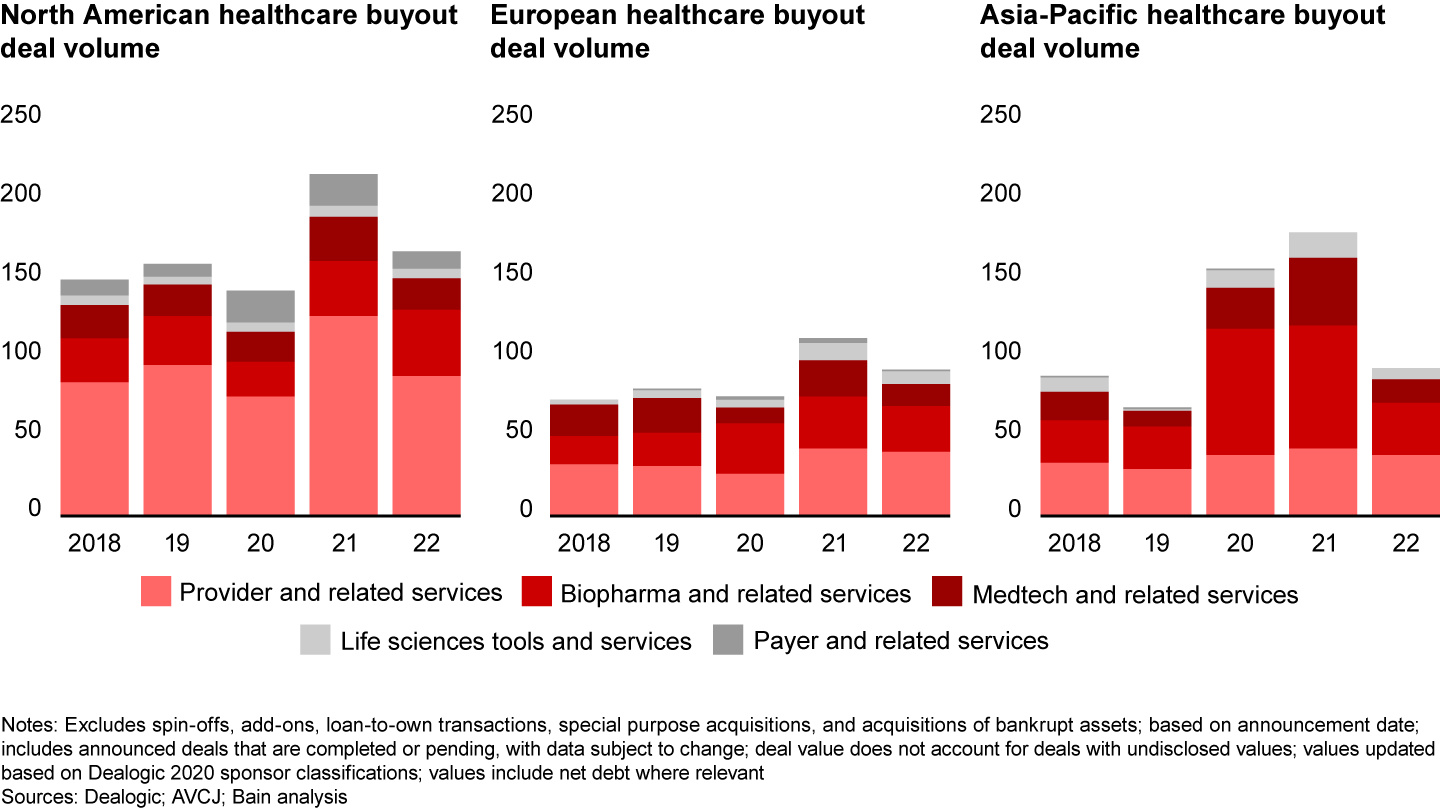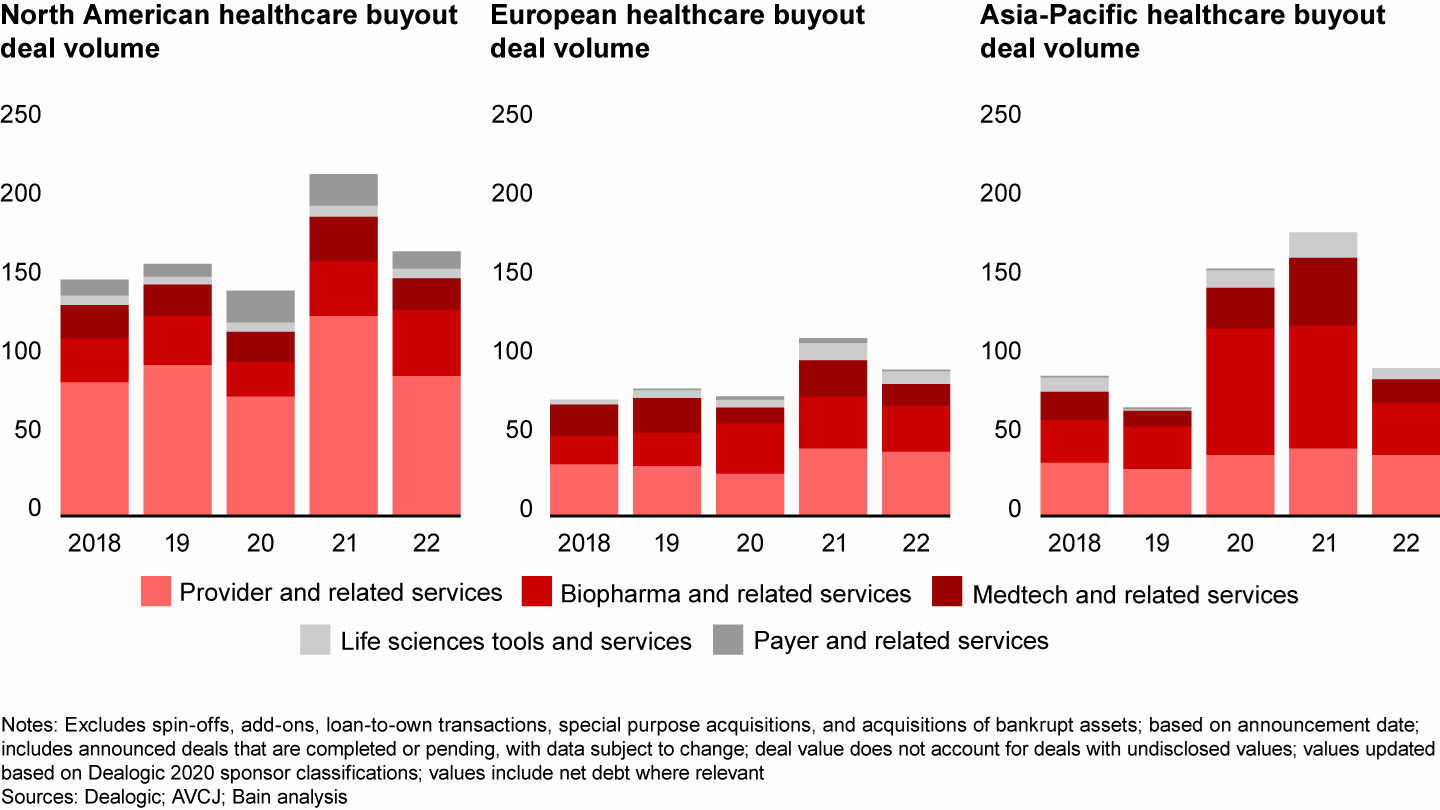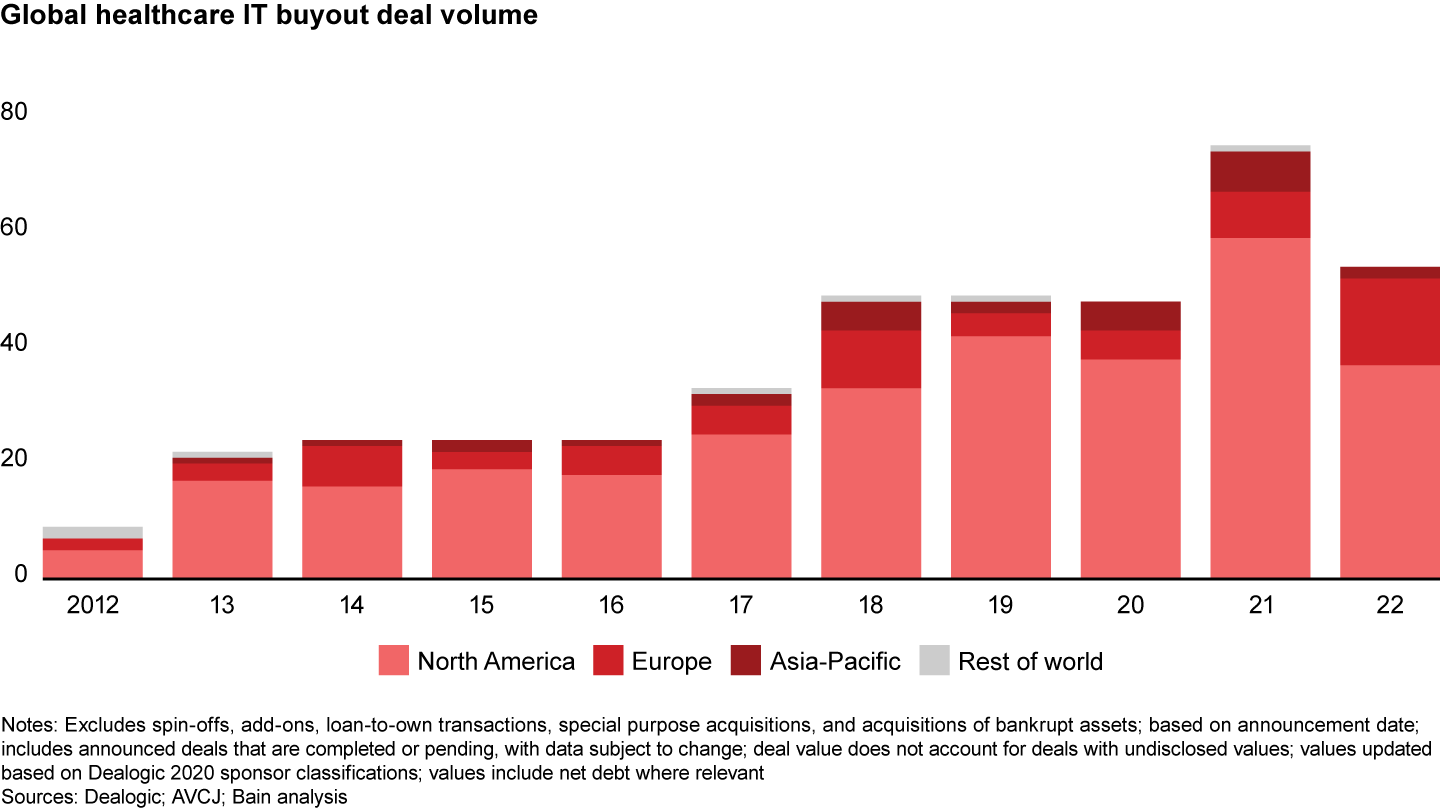Global Healthcare Private Equity Report

At a Glance
- Healthcare IT buyouts cooled off sharply after getting off to a hot start, reflecting macro environment challenges.
- Provider IT still accounts for the majority of healthcare IT deals, though the space is maturing as many assets have traded multiple times.
- As the fastest-growing subsectors in healthcare IT over the past 10 years, biopharma IT and payer IT present exciting opportunities for private equity investors.
- Growth equity investments suggest a bright future for healthcare IT.
This article is part of Bain's 2023 Global Healthcare Private Equity and M&A Report.
Healthcare has historically underspent on technology, accounting for only 6% of technology spending despite making up 20% of GDP. In 2022, healthcare IT (HCIT) buyout activity was a tale of two halves: A robust start to the year quickly gave way to challenges in the macro environment (see Figure 1). Despite that, HCIT buyout volume in 2022 added up to be the second highest on record (see Figure 2).




Provider IT continues to drive healthcare IT, though the space is maturing
Inflation and labor shortages have left providers seeking ways to alleviate margin pressure. In 2022, private equity played this theme by investing in provider IT solutions that help providers optimize resources and improve margins.
Businesses that optimize scarce provider resources focus on everything from personnel to durable assets. Intelligent Medical Objects, sold from Warburg Pincus to Thomas H. Lee Partners for $1.5 billion, standardizes clinical data in support of a range of patient care and clinical research use cases. The company’s solutions help providers streamline and enhance clinical documentation, supporting quality care and alleviating clinician burnout. Coming at the same themes from another angle, LeanTaaS offers predictive analytics solutions to optimize the utilization of operating rooms, infusion chairs, hospital beds, and other critical assets. Bain Capital acquired a majority stake in LeanTaaS from Insight Partners and Goldman Sachs Asset Management for an undisclosed sum.
Private equity’s investments in revenue cycle management (RCM) reflected providers’ desire to support margins by improving collections and reducing the cost to collect. These investments spanned from large companies like Coronis Health and Ensemble Health (see the chapter “Provider Information Technology: Mind the Gap” for more detail) to smaller firms with more specialized offerings. Linden Capital Partners, for instance, acquired a majority stake in Aspirion, a provider of RCM technology built to navigate complex reimbursements, from Aquiline Capital Partners. Altogether, these investments reflect a range of ways private equity played the same themes in 2022.
Provider IT is more mature than other areas of healthcare IT, with many assets on their second or third round of private equity ownership. Consequently, defining the value creation plan up front has become increasingly important to successfully investing in provider IT. Value creation plans may encompass end-market expansion, solution set expansion, or both. This is discussed in greater detail in the “Mind the Gap” chapter cited above.
While provider IT deals continue to grow annually, their share of total healthcare IT deal volume is declining: Provider IT accounted for 67% of healthcare IT deal volume in 2020–22, down from 76% in 2013–19. Healthcare IT investments are increasingly shifting toward the sector’s fastest-growing subsectors: biopharma IT and payer IT.
Biopharma IT and payer IT present exciting opportunities for investors
While the number of biopharma IT and payer IT deals is far smaller than the number of provider IT deals, deal volume for biopharma IT and payer IT has grown faster than that of provider IT over the past 10 years (see Figure 3).


Within biopharma IT, we see interest in businesses that use technology to support workflow productivity and reduce clinical trial length. Workflow productivity businesses that attracted investor interest provide software solutions that streamline lab tasks, generate insights into lab operations, and support scientists’ work while lowering costs. Summa Equity, for instance, acquired a majority stake in UgenTec, a software-as-a-service software provider focusing on workflow productivity for molecular diagnostic labs. Within the clinical trial technology space, investors targeted data and analytics solutions. Frazier Healthcare Partners played this theme in 2022, acquiring Apollo Intelligence. Warburg Pincus and Mubadala Investment Company similarly played this theme, carving out Informa’s Pharma Intelligence business (rebranded as Citeline) for $2.6 billion. Norstella—which is backed by Hg Capital, Welsh, Carson, Anderson & Stowe, and Warburg Pincus—ultimately added Citeline to its pharmaceutical technology platform via merger.
Payer IT deals reflect a continued interest in technology focused on payer administrative functions. The marquee deal of the year was TPG’s acquisition of ClaimsXten from UnitedHealth Group for $2.2 billion in conjunction with approval of the Optum and Change merger. ClaimsXten’s technology allows payers to reduce appeals, generate administrative savings, and improve payment accuracy.
Growth equity suggests continued enthusiasm for healthcare IT
In the near term, growth equity investors will need to confront hard questions about down rounds and other challenges stemming from the macro environment. They will also need to consider the impact of large tech firms making investments in artificial intelligence with healthcare in mind as a relevant use case. We do not expect these developments to impact the fundamental reasons that make healthcare IT an attractive place to compete. Growth equity’s sustained activity in healthcare IT across all subsectors provides a preview of where private equity might participate in the coming years.
In 2022, provider IT growth equity investment focused on innovative care delivery models, particularly those that improve patient outcomes by combining digital delivery and patient engagement capabilities. Biofourmis, Memora Health, Omada Health, and Equip Health—all of which fit this mold—completed financing rounds in 2022. Growth equity’s investment in innovative care delivery is an area to watch for buyout funds that may eventually acquire mature assets or that can tuck these capabilities into a broader platform.
Growth equity investments in payer IT and biopharma IT in 2022 were more consistent with the current focuses of private equity. Payer IT growth equity investments focus on functions like analytics and administrative processing (such as Revelstoke Capital Partners’ investment in HealthAxis) and benefits administration (such as Nayya’s $55 million Series C led by ICONIQ Growth).
Biopharma IT growth equity investments largely focused on supporting clinical trials and accelerating drug discovery. ConcertAI, Reify Health, Unlearn, and MDClone collectively secured just under $500 million in financing in 2022 to build clinical trial solutions ranging from study site software to synthetic data analysis platforms. Providers of drug discovery technology, like InSilico Medicine, were also areas of focus for growth equity investors.
Investors with strong expertise in data monetization are also finding opportunities in biopharma IT. We have seen this within precision medicine, which is the use of analytics and big data to improve pharma research and development and drive more personalized care for patients. Blackstone Growth led a $200 million investment in DNAnexus, a bioinformatics platform that provides scalable, next-generation tools to support multiomic analysis used in multiple downstream applications. More opportunities may be on the horizon, with Qiagen announcing in early 2023 that it is offering a minority stake in its bioinformatics division. Together, these signal that precision medicine may be hitting a point of potential scale. However, there are many different ways to play precision medicine, with an open question on the winning model overall and within different healthcare stakeholders.
As each HCIT subsector evolves, there will be opportunities for sponsors to draw on the most promising ideas from growth equity, while also tailoring value creation strategies to the relative maturity of each subsector.